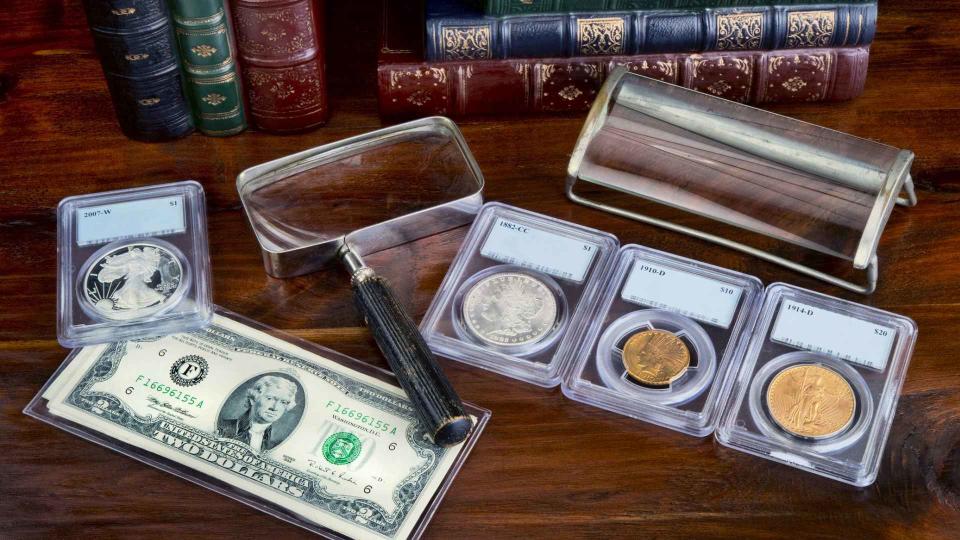Coin Collecting Is Not Just a Get-Rich-Quick Scheme: How Beginners Should Approach the Hobby

Coin collectors draw big headlines when they sell their rare coins for thousands or even millions of dollars, but the vast majority of collectors will never see such a payoff. The most valuable coins are so rare you need a ton of money just to invest in one. That doesn’t mean you can’t earn a decent profit on coins, however. Even beginners can do well by treating the hobby as a side gig instead of a get-rich-quick scheme.
See: Buffalo Nickels Could Be Worth Thousands — How To Spot One
Find: Pocket an Extra $400 a Month With This Simple Hack
The key is to put your focus on buying affordable coins and then having the patience to see them rise in value, just like any other investor. You don’t have to go for the big purchase and big payoff. Instead, build a large collection of cheaper coins that won’t break the bank.
The American Rarities website lists dozens of old and rare coins that you can get for very little money. Here are some examples from the 19th century:
Two Cent coins 1864-1871 (good to fine condition): $7.75 to $9.35.
Three Cent Nickels 1865-1881 (good to fine): $6.85 to $8.50.
Seated Half Dime 1837-1873 (good to fine): $11.00 to $12.75.
Seated Quarter 1838-1891 (good to fine): $15.25 to $18.00.
Barber Silver Half Dollar 1892-1915 (circulated): $9.60 to $10.75.
You can get rare coins from the 20th century even cheaper — often for $2 or less. By spending only a couple hundred dollars, you can start a decent rare coin collection that you might be able to sell for a profit just a few years down the road. If you have $1,000 or so to invest, you can buy a large quantity of valuable coins that will push your profit even higher. A profit of a couple hundred dollars will pay the water bill for three months for most U.S. households.
Another option is to invest in coins for their melt value. This mostly applies to silver coins, although you can do the same thing with copper coins as long as you follow strict guidelines.
Also: 6 Pennies from the 1900s Worth a Lot of Money
Sponsored: Owe the IRS $10K or more? Schedule a FREE consultation to see if you qualify for tax relief.
Check Numismatic Value Before Selling
With silver coins, the Oxford Gold Group recommends making sure the coins don’t have a higher numismatic value before deciding to sell them for their melt value. After you have researched their value on the collector’s market and determined that their melt value is higher, you have a few options.
As Oxford Gold Group noted, refineries will purchase “junk coins” for their silver content to melt down. You might also be able to sell your coins to local coin buyers, pawn shops, reputable silver-buying sites and silver exchanges. Some of these buyers will pay cash to purchase your coins for melt value.
Things are a little more complicated with copper coins. Pennies and nickels that contain copper, zinc and other metals have “great monetary value,” according to a blog from Atlanta Gold & Coin Buyers. Because of their value, it is illegal to melt down these metals down for the sole intention of selling to offshore or local metal scrap industries.
However, melting pennies or nickels for jewelry such as rings or necklaces is legal since this this is considered a creative rather than business practice. Presumably you could invest in copper coins that can be turned into jewelry that can then be sold at a profit.
You can also try selling your copper coins on Ebay or Craigslist to investors who are betting that the law against melting copper coins will one day change, therefore opening up a whole new market for pennies and nickels, according to a 2021 blog on the MoneyNing site.
If you are a beginner at coin collecting, The Spruce Crafts website recommends the following steps:
Start simple by purchasing small coin sets that are easy to assemble, then research their history and how to grade and price them.
Learn how to handle and store the coins properly to prevent damage.
Research the hobby online or by reading books such as “The Guide Book of United States Coins,” also known as the Red Book.
Join a local coin club to network, make connections and learn more about the hobby.
After building your collection, don’t be in a hurry to sell immediately. Give the coins time to appreciate in value.
More From GOBankingRates
This article originally appeared on GOBankingRates.com: Coin Collecting Is Not Just a Get-Rich-Quick Scheme: How Beginners Should Approach the Hobby
